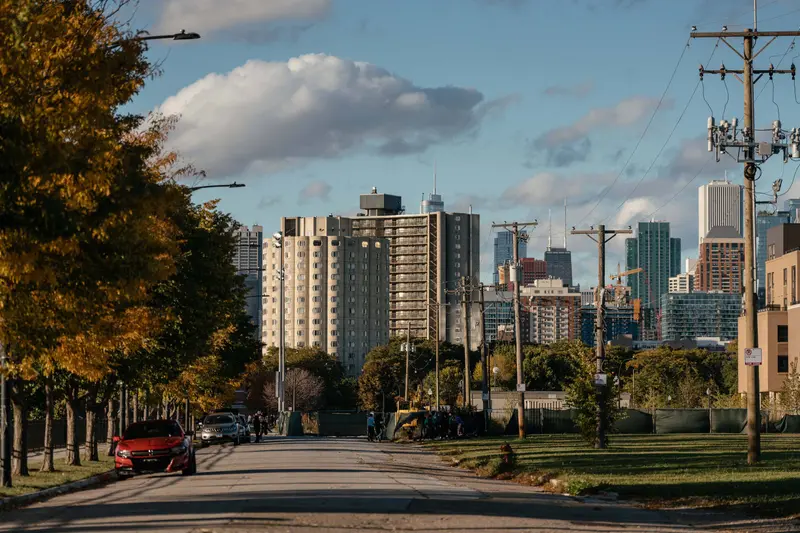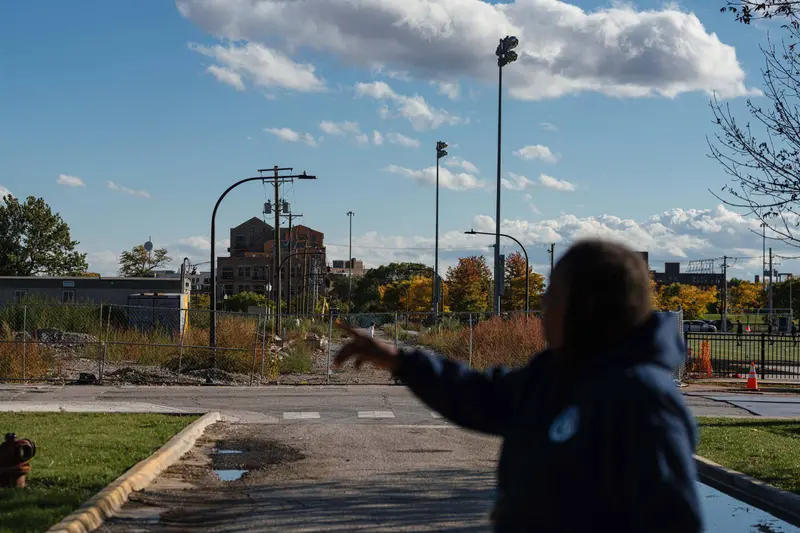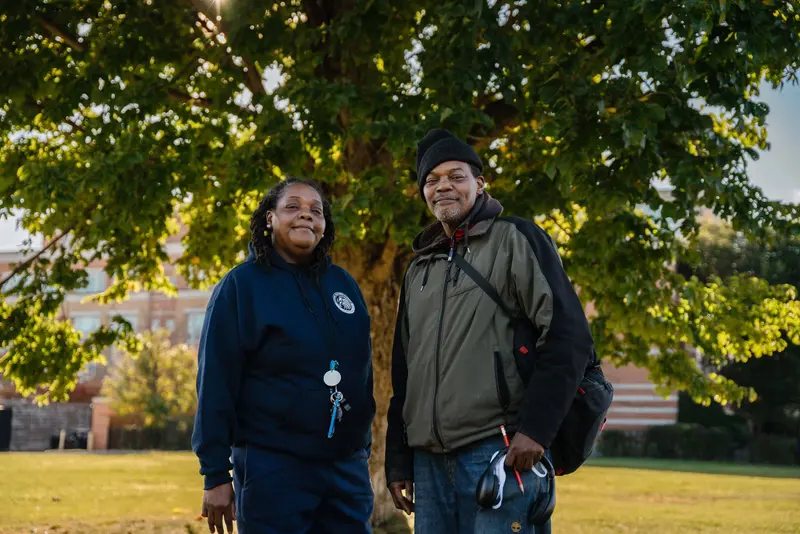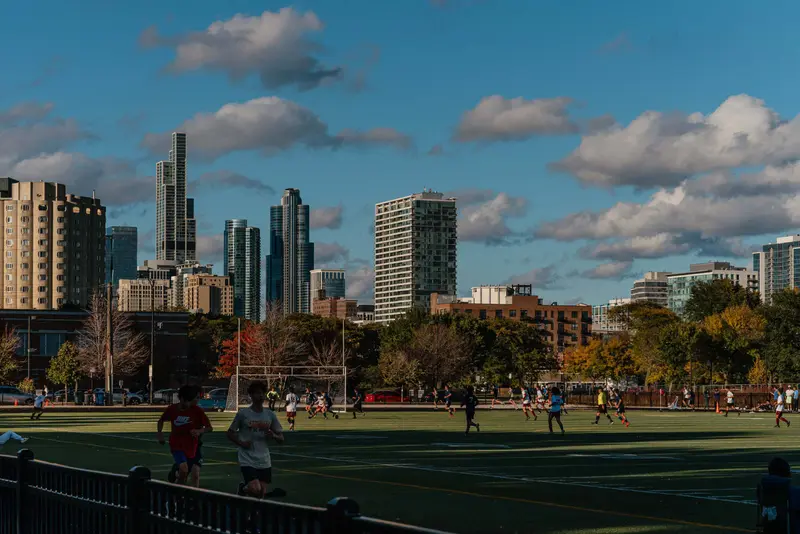The deal had been orchestrated by Chicago Mayor Lori Lightfoot, but even her allies knew the optics were bad: Land long set aside for low-income housing would be turned over to a professional soccer team owned by a billionaire. And criticism was intensifying.
Bombarded with questions during a City Council committee meeting last month, a local housing official stressed that the deal would be scrutinized by the U.S. Department of Housing and Urban Development before it could proceed.
That assurance helped the mayor’s allies win approval in the council. Later that day, the Chicago Housing Authority sent an application asking HUD to sign off on the deal.
But if the past is any indication, the outcome of the federal review is hardly in doubt. Over the last decade, HUD has never blocked a public housing land deal in Chicago, according to records from HUD and the Chicago Housing Authority.
With HUD’s consent, the CHA has essentially become a land piggy bank for other government agencies and the private sector. Through sales, leases and swaps, the agency has turned over land for two Target stores on the North Side, a privately owned tennis complex on the South Side, and infrastructure in gentrifying neighborhoods, such as a fire house and a police station on the Near West Side.
HUD ultimately approved more than a dozen land transactions while applying little pressure on the CHA to measure the benefits for residents or produce more affordable housing. In several cases, the agency agreed to accept far less than a property’s market value.
The approvals in Chicago are part of a larger pattern. ProPublica found that HUD routinely signs off on plans to get rid of property owned by public housing authorities across the country, including in Atlanta, Philadelphia and Milwaukee.
In Chicago, the CHA justified its actions by saying the deals would generate more money for housing. Yet the projected units have been delayed repeatedly, and some didn’t materialize at all.
This wasn’t what was promised. In 2000, HUD officials helped the CHA launch its Plan for Transformation, a citywide effort to dismantle and redevelop public housing sites. As the CHA leveled most of its apartment buildings, thousands of families had to find new places to live. Within a few years, the agency was sitting on blocks of open land. Officials committed to building new homes for families with a range of income levels.
Two decades later, some of the former public housing sites have been rebuilt and are thriving, but many parcels remain empty, and the agency still needs to build hundreds of units of housing to comply with court agreements.
The Near West Side deal that Lightfoot is pushing would let the Chicago Fire build a new practice facility on CHA-owned land that was long reserved for new housing. The team is owned by billionaire Joe Mansueto, a Lightfoot ally. Questions about the deal grew after ProPublica and WTTW-TV published a story about it in June.
In August, housing advocates sent a letter to HUD officials asking them to oppose the Fire agreement. The CHA’s failure to build promised new homes “must not serve as a basis to jettison an important supply of coveted, available public housing land in a gentrifying community,” they wrote.
These types of deals show how the CHA has drifted away from its mission to provide affordable housing, said Don Washington, one of the authors of the letter to HUD. Washington is executive director of the Chicago Housing Initiative, a coalition of community organizations.
“What it’s doing is getting the CHA and HUD out of the business of creating brick-and-mortar housing for low-income, mostly Black and brown children and families,” he said. “They’re instead building new facilities for new people.”
CHA officials say they want to develop their land with more than housing. “CHA’s investments in communities go beyond replacing the failed public housing model of the past,” an agency spokesperson wrote in a statement.
Agency officials say they have used a formal procurement process to select developers for many of their sites. But in other instances, they have accepted pitches from businesses, nonprofit organizations and other government entities on a case-by-case basis, without soliciting competitive bids.
CHA officials say the land deals fit into the agency’s strategy of “mixed-income, mixed-use” development that leads to “economic independence,” and some residents and community leaders have welcomed that approach.
“Housing is our middle name,” Ann McKenzie, the CHA’s chief development officer, said at a recent city planning meeting. But, she added, “we can use some of this space for other things people want and need in their lives.” That could include schools, parks, jobs, health care access and grocery stores, McKenzie and other CHA leaders say.
For their part, HUD officials say they have little control over the CHA’s land management strategies and are limited to reviewing proposals one at a time.
Those reviews are meant to ensure that housing authorities follow a “fair and open process” while “residents’ voices are heard,” according to a statement from HUD. It added that land deals can generate money for housing and other community needs.
“HUD takes its obligation to enforce statutory requirements very seriously and will continue to do so,” Diane M. Shelley, the department’s Midwest regional administrator, wrote in a statement. She added that increasing the supply of affordable housing is “a high priority for the Biden-Harris administration.”
HUD’s Rubber Stamp

By law, local housing authorities are not allowed to dispose of public housing property unless low-income residents will benefit or the property is no longer needed.
No public housing land deals advance without HUD’s support. Its Special Applications Center is responsible for making sure that the property transactions comply with the law, and that they have been discussed with residents and have support from local government leaders.
To examine the volume and outcomes of these applications, ProPublica submitted open records requests to HUD, the CHA and housing authorities in six other cities. Each agency tracks land dispositions differently, and in many cases the CHA and HUD didn’t provide the same documents for the same transactions, making it challenging to get precise counts of such deals. But taken together, the records offer a revealing portrait of how the process works.
Records show that since 2011, HUD greenlit every property disposition application — more than 100 — from housing authorities in Chicago; Atlanta; Baltimore; Memphis, Tennessee; Milwaukee; Philadelphia; and Pittsburgh, all of which have received large revitalization grants from the agency.
HUD authorized plans to raze old apartment buildings, transfer land for new housing and redevelopment projects, and sell properties to private investors. But only the CHA appears to have received approval for so many applications that didn’t involve building new housing, according to the records.
CHA officials said that’s because the agency has a larger footprint than the other housing authorities.
A land deal on Chicago’s Near West Side illustrates HUD’s tendency to go along with CHA plans. In 2019, HUD allowed the CHA to give an acre of land in the ABLA Homes area to a local nonprofit for much less than its market value. Though an appraisal concluded that the parcel was worth $2.7 million, the CHA agreed to lease it to SOS Children’s Villages Illinois for $1 a year over 99 years so the nonprofit could build a community center. In return, SOS promised to provide social services to CHA families.
Some residents opposed the land transfer because there was an existing community center just two blocks away. In addition, they pointed out, the CHA had only constructed a fraction of the housing units promised for the redevelopment of ABLA, where 3,600 families lived before much of the complex was razed. But HUD signed off on the deal, agreeing with the CHA that it was “in the best interest of the public housing residents.”
The SOS community center is two blocks from the 23-acre site the CHA wants to lease to the Chicago Fire soccer team so it can build a new training facility.
Records show that CHA officials encountered HUD speed bumps just twice, and both ended up being temporary. On one occasion, HUD held up the sale of a vacant two-unit building to a county agency that planned to have it rehabbed. HUD determined some paperwork was missing from the CHA’s application, but once that was provided, HUD backed the sale.
The other delay was prompted by deeper concerns. In 2013, the administration of then-Mayor Rahm Emanuel engineered a land swap between the CHA and the city. The CHA gave up a vacant block that was formerly part of the Ickes Homes, a Near South Side development where 1,000 families lived before the apartment buildings were demolished in the Plan for Transformation. The city used that Ickes block to build a running track and turf field for a public, selective-enrollment high school a mile and a half away.
In return, the CHA received almost 10 acres on the Near North Side, across the street from the site of the CHA’s former Cabrini-Green complex. The CHA made plans to use that land for housing and retail as part of its Cabrini redevelopment.
HUD approved the land swap. But the process hit a snag when the CHA sought permission to transfer almost half of the Near North Side property — including an existing baseball diamond — to the Chicago Park District.
Attorneys for the Cabrini-Green Local Advisory Council, the development’s elected residents’ group, opposed the move. They argued that the CHA should not get rid of land at Cabrini until the agency had delivered the 1,800 affordable housing units it had agreed to as part of a 2015 federal consent decree, which resulted from litigation to force the CHA to fulfill its promises. Then, as now, more than 30,000 people were waiting for housing assistance from the CHA.
“Displaced CHA residents and applicants on CHA’s waitlist have been waiting too many years for replacement housing in the revitalized Cabrini Green neighborhood, and disposing of four acres of valuable land before CHA can show its ability to replace the minimum 1,800 subsidized units without this land is unjustifiable,” wrote Richard Wheelock of the Legal Assistance Foundation, now known as Legal Aid Chicago, and Jeff Leslie from the University of Chicago Law School.
That’s when HUD took the unusual step of pausing the CHA’s land transfer. The federal agency cited the attorneys’ letter and questioned the CHA’s rationale for giving the land to the Park District for free when it was appraised at more than $17 million. HUD determined the CHA’s application for approval was “substantially incomplete.”
In the following months, the CHA submitted new documents stating that Cabrini residents wanted more park space. Agency officials noted that they had received twice as much land as they had given up in the original swap, arguing that they would still have plenty of property left for the housing they were obligated to build at Cabrini.
That was good enough for HUD, which approved the deal.
The Near North Side property now includes a park; when a ProPublica reporter visited on multiple occasions this summer and fall, it was largely used by white residents.
The parcel planned for Cabrini housing remains vacant and enclosed by fencing.
New Priorities

Over the last decade, the CHA has made no secret that it is open to land deals. The 2008 housing market collapse left it years behind in its commitments to build new homes, and in 2013 agency leaders appointed by Emanuel released a strategy statement, “Plan Forward.”
Its new goals included using vacant land for “long-term public and private investment” and “creative, community-building purposes” such as “performance or sports spaces.” HUD endorsed the plan.
CHA officials applied this new philosophy when leaders of XS Tennis, a nonprofit, approached the agency about acquiring 13.5 acres for a new athletic complex. The property, part of the former Robert Taylor Homes site on the South Side, was estimated to be worth $4 million, but the CHA agreed to sell it for half that when XS promised to provide free tennis lessons and tutoring to low-income youth.
HUD accepted the CHA’s justification for the XS Tennis deal in a 2015 letter, agreeing it was “in the best interest of the public housing residents.”
In a statement to ProPublica, the CHA said XS had followed through on the opportunities it had pledged to deliver, providing residents with access to the tennis center, academic tutoring and jobs.
The CHA plans to replace the Taylor homes with a new development, Legends South, that includes 2,400 total units, some integrated into the surrounding neighborhood. So far the agency has finished fewer than 500.
Despite its struggles to rebuild former public housing sites, CHA officials say they now serve more households than ever, largely by issuing 45,000 vouchers that can be used to subsidize rent in the private market.
But housing advocates say too many families still need help finding decent places to live amid a housing shortage and a spike in homelessness. More than 30,000 people are on the CHA’s waiting lists for public housing and for vouchers.
“The goals of the CHA need to return to providing public and affordable housing,” said Emily Coffey, senior counsel for the Chicago Lawyers’ Committee for Civil Rights.
“And HUD has an obligation to make sure that each and every disposition complies with civil rights laws and holds CHA to its commitment to replace lost public housing units.”
Another Disputed Deal

In addition to the Chicago Fire agreement, it’s likely that the CHA will soon ask HUD to sign off on another hotly debated land deal that opponents believe will fuel more gentrification and displacement.
At a board meeting in July, CHA officials explained that the Chicago Public Schools had approached them about acquiring 1.7 acres of undeveloped property at the Ickes site on the near South Side. The school district wants to build a new high school there to serve the booming South Loop and Chinatown neighborhoods, as well as some South Side CHA developments.
In return for its property, the CHA would get a parcel a block away that McKenzie, the agency’s chief development officer, described as “pretty expensive.”
Tracey Scott, the CHA’s chief executive officer, argued that the agency would give up little for such a payoff. She acknowledged that the CHA had long planned to put new housing on its vacant Ickes land, but those plans would be changed. As a result of the land swap, the CHA would “increase the density” of the new housing and fit it into a smaller space near the school, Scott said.
“We felt this opportunity was available that would benefit the residents,” Scott said.
McKenzie also noted that two new apartment buildings, including 68 units reserved for public housing residents, are almost ready to open at Ickes. The agency still has to build additional units for the Ickes site, including another 176 for CHA families.
The school plan won the backing of the local alderman and some parents. But many CHA residents and Black community leaders have blasted it. The school district should invest in existing high schools, they say, and the CHA should build the replacement homes it committed to after forcing out hundreds of families who once lived at Ickes.
Audrey Johnson, whose family has deep roots at Ickes, has watched those promises get broken as the land grows more valuable.
Her grandfather and his 10 children were among the first residents at Ickes in 1955, and Johnson’s family — her parents and three brothers — moved there in 1970, when she was 1. Her mother worked for a railroad and then the post office; her dad was a janitor at Ickes for 30 years. The family lived at the south end of Ickes, land where the new school would be built.
While she now lives several miles away, Johnson has worked for 20 years as a lunchroom supervisor and student aide at the National Teachers Academy, a public elementary school that was built on the Ickes site even before the public housing buildings were torn down. In recent years, two of her adult children also started working at the school.
“I’ve been here all my life,” she said.
Johnson said she’s all in favor of quality schools — that’s why she works in one. But she said Black residents are tired of seeing public facilities in their communities closed or destroyed, then replaced with new infrastructure when the neighborhoods begin to gentrify.
“I think they’re trying to push us out,” Johnson said. “They’re trying to push the Black and the brown to the suburbs. And eventually they will if we allow them to.”

















